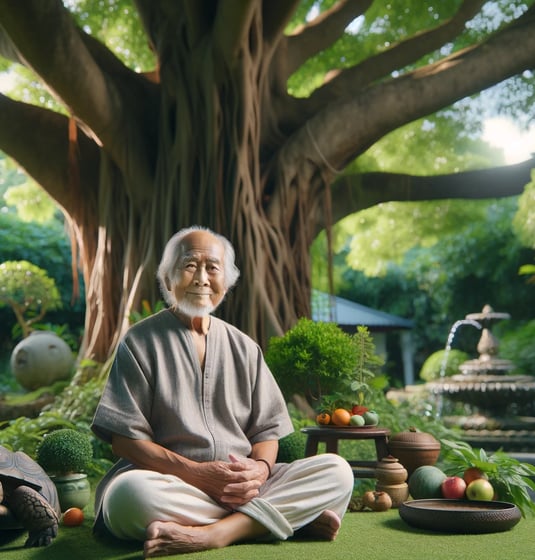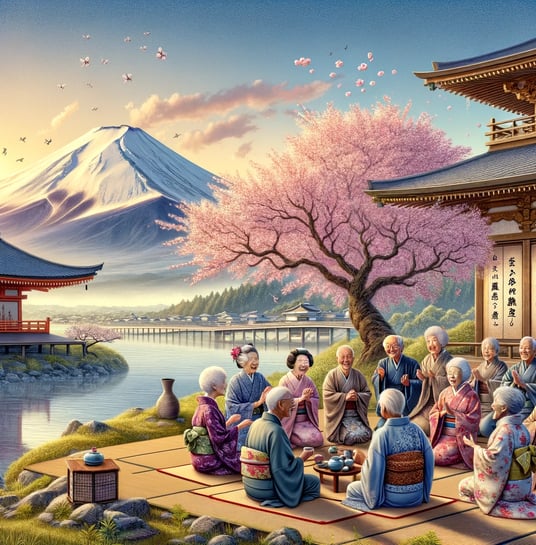

I K I G A I
- Francesc Miralles & Hector Garcia
Here is an extensive and in-depth summary of the book 'Ikigai' authored by Francesc Miralles & Hector Garcia, offering a comprehensive overview of its key insights and concepts.
生き甲斐
"The Japanese Secret to a Long and Happy life"


Chapter 1: Ikigai. The Art of Staying Young While Growing Old
Chapter 1 of "Ikigai: The Japanese Secret to a Long and Happy Life" introduces ikigai, meaning "a reason for being" or "a purpose in life" in Japanese. Ikigai refers to what gives life meaning, typically found at the intersection of what you love, what you are good at, what the world needs, and what you can be paid for.
The authors conducted research in Okinawa, known for its high concentration of centenarians, focusing on the town of Ogimi. They found that the residents lead lives that are intensely active yet relaxed, with everyone pursuing their ikigai in a balanced manner. Key aspects of this lifestyle include growing vegetable gardens, engaging in community activities, maintaining strong social ties, and a general spirit of optimism and non-worry.
Ikigai is identified as a central element of the Okinawan way of life, underlying their remarkable longevity. The chapter asserts that discovering one's ikigai involves a patient search, advocating for a balanced approach to life and emphasizing the importance of doing what you love in the company of supportive people. It highlights that while finding ikigai requires effort, it is equally about letting ikigai find you. The methods of logotherapy and Morita therapy are suggested as tools to aid in this discovery.


Chapter 2 of "Ikigai" focuses on anti-aging secrets, emphasizing the importance of a youthful mind and healthy lifestyle. Key points include:
Mind-Body Connection: Mental exercise is vital, as neglecting the mind can lead to neuron and neural connection deterioration.
Stress Management: Chronic stress is harmful, but small amounts can be beneficial. Managing stress effectively is crucial for health and longevity.
Physical Activity and Sleep: Regular physical activity and getting 9 to 10 hours of sleep per night are recommended. Sleep is highlighted as an important anti-aging tool.
Positive Attitude: A calm and positive approach to life's challenges helps reduce stress and maintain youthfulness.
Brain Engagement: Activities like cognitive games, outdoor activities, and social interactions are encouraged to keep the brain active and flexible.
Mindfulness Practices: Mindfulness, exercise, and yoga are suggested for stress reduction, fostering a deeper connection with the mind and body.
Overall, the chapter advocates for a holistic approach to longevity, combining mental and physical health, stress management, and a positive mindset.
Chapter 2 : Antiaging Secrets. Little Things that Add Up to a Long and Happy Life


Chapter 3 : From Logotherapy to Ikigai: How to Live Longer and Better by Finding Your Purpose
Chapter 3 of "Ikigai" titled "From Logotherapy to Ikigai: How to Live Longer and Better by Finding Your Purpose" explores the importance of finding one's purpose in life through the lenses of logotherapy and Morita therapy.
Logotherapy: Developed by Viktor Frankl, logotherapy is a form of psychotherapy that helps people find meaning in life. Frankl believed that even in extreme conditions like concentration camps, individuals could choose their attitude. Logotherapy guides individuals to understand that their negative feelings and neuroses stem from a desire for a meaningful life. It emphasizes that life's meaning is discovered, not created, and it evolves over time. The process involves realizing one's life purpose (ikigai) and accepting it, enabling them to overcome challenges.
Morita Therapy: A Japanese form of life therapy, Morita therapy, starts with the acceptance of emotions rather than trying to control them. Patients are initially put on bed rest to observe their emotions in silence. Gradually, they are reintroduced to activities like gardening and wood chopping, keeping a diary, and doing breathing exercises. This process helps clear mental-emotional clutter, leading to a clearer understanding of one's purpose. The ultimate goal is rejoining the world with a renewed sense of purpose.


Chapter 4 : Find Flow in Everything You Do: How to Turn Work and Free Time Into Spaces for Growth,
Chapter 4 titled "Find Flow in Everything You Do: How to Turn Work and Free Time Into Spaces for Growth," explores the concept of 'flow' and its significance in finding and living one's Ikigai.
Flow and Ikigai: The chapter discusses how being engrossed in activities one enjoys leads to a state of flow, a concept popularized by Mihaly Csikszentmihalyi. This state is characterized by joy, inspiration, and being fully present in the moment. Achieving flow is essential for living according to one's ikigai.
Conditions for Flow: The chapter references Owen Schaffer’s research, outlining conditions necessary for achieving flow: having the skill to accomplish the task, knowing what and how to do it, being aware of how well one is doing, and understanding where to go in activities involving navigation.
Approaches to Achieving Flow: The author suggests choosing activities that are challenging but not overly difficult. This balance enables individuals to engage deeply with the task and find enjoyment in the effort and progress made.


Chapter 5 : Master of Longevity. Words of Wisdom from the Longest-Living People in the World.
Chapter 5 of "Ikigai: The Japanese Secret to a Long and Happy Life" delves into the lives of the world's longest-living people, primarily focusing on those residing in Blue Zones such as Okinawa, Japan. The chapter provides an insightful exploration into the daily practices, dietary habits, and life philosophies that contribute to their extraordinary longevity. Central to their lifestyle is the concept of "Ikigai," which translates to a sense of purpose or a reason for being. This foundational belief is seen as a driving force behind their sustained health and happiness.
The dietary habits of these centenarians are given particular attention. Emphasizing a plant-based diet, the book outlines how these individuals consume a variety of vegetables, grains, and soy products, and practice "Hara Hachi Bu" – eating until they are only 80% full. This approach to eating aids in maintaining a healthy weight and promotes longevity. Physical activity, seamlessly integrated into their daily routines through gardening, walking, and household chores, is also a key aspect of their lifestyle. Such regular, moderate exercise is shown to have significant health benefits.
Moreover, the chapter highlights the importance of social engagement and stress management in achieving a long life. Strong social networks and active participation in community life contribute to emotional and mental well-being. Equally, effective stress management techniques, including mindfulness and gratitude practices, are common among these individuals. The overall message of the chapter is clear: a balanced diet, regular physical activity, strong social ties, a clear sense of purpose, and a positive attitude towards life are not just the secrets to longevity but also to a happy and fulfilling life.


Chapter 6 : Lessons from Japan’s Centenarians. Traditions and Proverbs for Happiness and Longevity.
Chapter 6 of "Ikigai: The Japanese Secret to a Long and Happy Life," titled "Lessons from Japan’s Centenarians," delves into the lifestyles and wisdom of Japanese individuals who have lived for over a hundred years. The authors, Héctor García and Francesc Miralles, explore the shared traits and practices of these centenarians to uncover the secrets of their longevity and well-being. The chapter emphasizes the importance of a balanced, predominantly plant-based diet, highlighting the traditional Japanese diet that is rich in vegetables, fish, and rice, and its role in health and longevity. Regular, low-intensity physical activities like gardening and walking are common among these elders, underlining the significance of staying active to avoid a sedentary lifestyle.
Social and community engagement also plays a crucial role. The chapter reveals that these centenarians often have active social lives and strong community ties, fostering a sense of belonging and purpose, crucial for mental and emotional health. A positive outlook on life, resilience in adversity, and mental agility are identified as key mental traits. Many of the centenarians continue to engage in hobbies and activities that keep their minds sharp. Additionally, the role of spirituality and adherence to cultural traditions is discussed, highlighting how these aspects contribute to a sense of peace and fulfillment. Through these observations, Chapter 6 offers practical insights into the practices and attitudes that can contribute to a longer, healthier, and more fulfilling life.


Chapter 7 : Busy, Active, and Connected to the World
Chapter 7 of "Ikigai: The Japanese Secret to a Long and Happy Life" by Héctor García and Francesc Miralles, titled "Busy, Active, and Connected to the World," focuses on the importance of staying engaged and active throughout life. This chapter delves into the principle that maintaining a certain level of activity and involvement in the world, even in old age, is key to longevity and happiness.
The authors explore the concept of remaining "busy" in a positive sense, emphasizing the value of having responsibilities and tasks that provide a sense of purpose and direction. This busyness is not about stress-inducing overwork but about engaging in meaningful activities that bring joy and a sense of accomplishment. The chapter highlights how many centenarians continue to involve themselves in various activities, including hobbies, community work, and even continued professional work in some cases.
Furthermore, the chapter discusses the significance of being connected to the world around us. This connection is not just about physical activity, but also about maintaining social relationships, staying intellectually engaged, and being part of a community. The authors suggest that this connectedness is crucial for mental and emotional health, providing a sense of belonging and reducing feelings of isolation and loneliness.


Chapter 8 of "Ikigai: The Japanese Secret to a Long and Happy Life," authored by Héctor García and Francesc Miralles, is titled "A 100-Year-Old’s Diet." This chapter delves into the dietary habits and principles that contribute to the longevity of centenarians, particularly focusing on the residents of Okinawa, Japan, a region known for its high number of long-lived individuals.
The chapter outlines the dietary patterns common among these centenarians, emphasizing a low-calorie diet that is rich in natural, unprocessed foods. The diet primarily consists of a variety of vegetables, whole grains, soy products, and a moderate amount of fish, with minimal consumption of meat and processed foods. This way of eating aligns with the traditional Okinawan diet, which is low in calories yet high in nutrients, particularly antioxidants and healthy fats.
A significant aspect highlighted in the chapter is the practice of “Hara Hachi Bu,” a Confucian teaching that advises eating until one is 80% full. This practice is seen as a way to prevent overeating and helps in maintaining a healthy body weight, which is crucial for longevity.
The authors also discuss the social aspects of eating, such as sharing meals with family and friends, and how this contributes to a satisfying and balanced life. The importance of a mindful approach to eating, appreciating the flavors and textures of food, and eating slowly, is emphasized as a way to enhance overall well-being.
Chapter 8 : A 100-Year-Old’s Diet.

